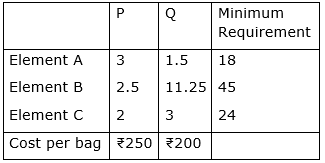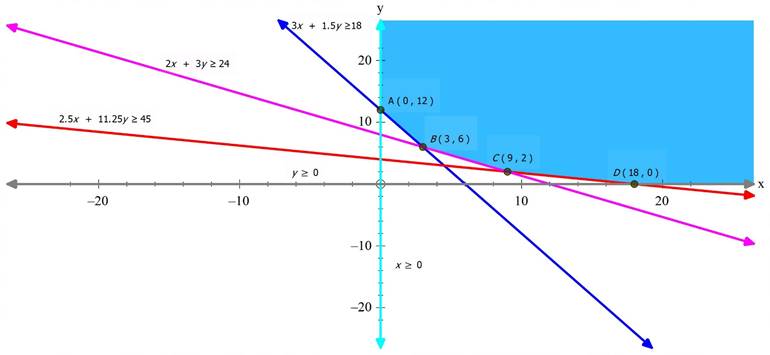A farmer mixes two brands P and Q of cattle feed. Brand P, costing ₹ 250 per bag, contains 3 units of nutritional element A, 2.5 units of element B and 2 units of element C. Brand Q costing ₹ 200 per bag contains 1.5 units of nutritional element A, 11.25 units of element B, and 3 units of element C. The minimum requirements of nutrients A, B and C are 18 units, 45 units and 24 units respectively. Determine the number of bags of each brand which should be mixed in order to produce a mixture having a minimum cost per bag? What is the minimum cost of the mixture per bag?
The above information can be expressed with the help of the following table:

Let ‘x’ bags of P and ‘y’ bags of Q be bought.
Cost of P = 250x
Cost of Q = 200y
Cost of mixture = 250x + 200y
Now,
⟹ 3x + 1.5y ≥18
i.e. the minimum requirement of element A from both P and Q combined is 18units, each of which has 3units and 1.5units of element A.
⟹ 2.5x + 11.25y ≥ 45
i.e. the minimum value of element B from both P and Q combined is 45units, each of which contains 2.5units and 11,25units of element B.
⟹ 2x + 3y ≥ 24
i.e. the minimum value of element C from both P and Q combined is 24units, each of which contains 2units and 3 units of element C.
Hence, mathematical formulation of the above LPP is as follows :
Find ‘x’ and ‘y’ that:
Minimises Z = 250x + 200y
Subject to the following constraints:
(i) 3x + 1.5y ≥18
(ii) 2.5x + 11.25y ≥ 45
(iii) 2x + 3y ≥ 24
(iv) x,y ≥0 (∵ quantity cant be negative)

The feasible region is unbounded
The corner points of the feasible region are as follows:

Z is minimised at B(3,6) i.e. 3 bags of P and 6 bags of Q should be purchased to achieve the minimum cost of the mixture per bag.
The minimum cost of the mixture is ₹1950.